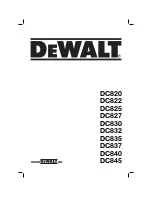
11
USE AS A BATTERY CHARGER
(
figures of pages 4 and 5)
•
Determine the voltage of the battery to be charged (fig. 1 and 2).
•
Connect the negative cable (with black clamp) to the terminal on the battery charger indicating the output voltage rate corresponding to the voltage
of the battery to be charged (fig. 3).
•
Connect the clamps to the battery: red one (+) to positive pole and black one (-) to the negative pole.
•
Warning: ensure to have done correct connections (fig. 4).
•
The positive pole of the battery has a larger diameter than the negative one.
•
If the battery is fitted to the vehicle, determine which pole is earthed to the vehicle chassis (consulting the instructions manual of the vehicle).
•
If the vehicle is positive earth, connect black clamp (-) to negative battery terminal and red clamp (+) to vehicle chassis far away from the battery and
from the carburettor duct; if, on the contrary, the vehicle is negative earth, connect red clamp (+) to positive pole of battery and connect black clamp
(-) to vehicle chassis, following the same precautions as above outlined.
•
Connect the charger to the mains supply (fig. 5), place the switch on "CHARGE"
position (fig. 6) and adjust the intensity of the current by the
switches 1 - 2 and min - max (fig. 7 and 8). Switch on the machine by the switch O – I (fig. 9).
•
When the battery is fully charged, switch off the battery charger (fig. 10), disconnect it from mains supply (fig. 11), then remove the clamps from the
battery (fig. 12 and 13). If the battery is on a vehicle, after having disconnected the charger from the mains supply, first disconnect the charger clip
that is connected to the chassis and then the clamp connected to the battery terminal.
USE AS A STARTER
(
figures of pages 6 and 7)
•
This equipment is unsuitable for starting vehicles with electronic control units.
•
After having determined the voltage of the plant of the vehicle to be started and which battery pole is connected to the chassis, connect the charger
clamps to the battery as in charging section (fig. 1, 2, 3 and 4). Follow the same procedure and precautions as outlined in previous instructions.
•
Put the light switch on O (fig. 5a).
•
Put the switch on starting position
(fig. 5b), connect the charger to the mains supply (fig. 6).
•
Put the light switch on I position (fig. 7) for the time needed to start the vehicle.
•
When the starting operation is finished, switch off the battery charger (fig. 8). Remove the charger power cord from mains supply (fig. 9), then
remove the battery charger clamps (fig. 10 and 11) as indicated in charging section.
PROBLEM CHECKLIST
Before any intervention on your battery charger always remove the power cord plug from the mains supply.
In case of failure check :
•
To have followed procedure and precautions as indicated in instructions.
•
Battery status: batteries discharged for long periods or sulphated cannot be easily charged.
•
That mains supply is available.
•
Good connection between charger clamps and battery terminals.
•
That the fuse is in working order (if not, use one with the same capacity).
•
That the thermostat that is placed on the transformer is not temporarily open due to a previous overload of the unit.
NOTE :
A fully charged battery may not be able to start a car if the battery connectors are loose or corroded.
Summary of Contents for START 420
Page 4: ...4 1 2 3 4 5 6 7 8 MAX MIN 2 1...
Page 5: ...5 9 10 11 12 13...
Page 6: ...6 1 2 3 4 5a 5b 6 7...
Page 7: ...7 8 9 10 11...










































